Whether you’re making a classic cheesecake, or a flavorful variation like lemon cheesecake, amaretto cheesecake, cinnamon swirl cheesecake, or pecan pie cheesecake, it’s helpful to know the what, why, and how of baking a cheesecake in a water bath. For picture-perfect, tall, and smooth cheesecake, you don’t want to skip this imperative step. Use my video tutorial as a guide.
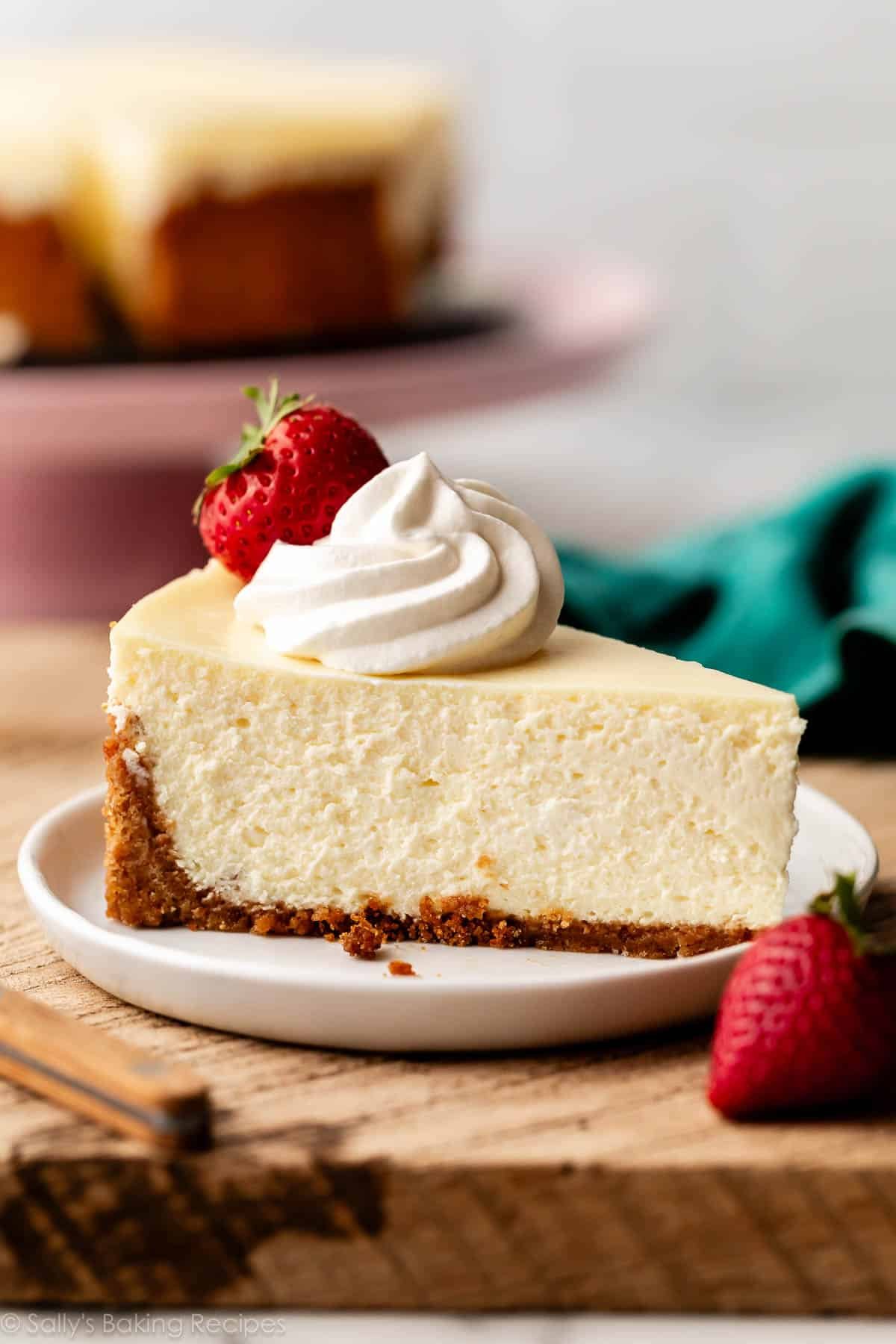
What Is a Cheesecake Water Bath?
Baking your cheesecake in a water bath is the best way to ensure cheesecake success. Don’t worry—you don’t have to buy any special equipment or a fancy bathtub-size baking appliance! It simply means placing the springform pan with the unbaked cheesecake in it inside a larger pan with hot water in it.
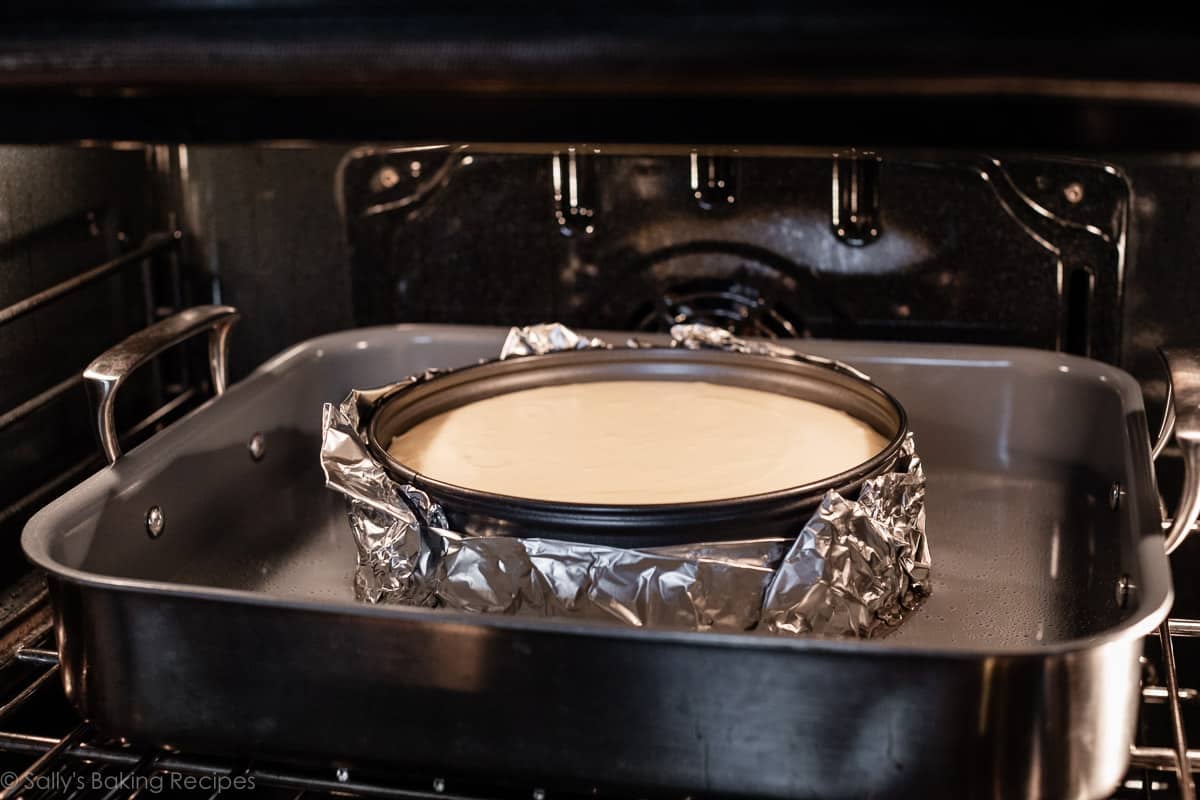
Why Should I Bake Cheesecake in a Water Bath?
We’re essentially adding steam to the baking and cooling steps. Why do we do this? Is it because this is a high-maintenance dessert that demands a spa treatment? Well, actually, sort of!
Cheesecake loves a humid environment, and we want to give it the best chance of baking up smooth, creamy, tall, and crack-free. Here’s why:
- Cheesecakes Are Egg-Heavy: Eggs need a moist and humid environment to properly rise and avoid drying out or burning.
- Prevent Cracks in the Surface: The steam from the hot water will lift the cheesecake up slowly and evenly, reducing the risk of cracks on the surface. You can read more about this in this post on How to Prevent Cracks in Cheesecake.
- Prevent Sinking: Starting the cooling process in the oven, still in the water bath, makes for a slow and even cool-down, which helps prevent the cheesecake from sinking back down as it cools. Cheesecakes are not fans of sudden temperature changes. (Chocolate soufflé is… they like to sink!)
Check out the photos below. As you can see, taking a few extra minutes to prepare a water bath for your cheesecake is well worth it. Look at these differences, using the same exact cheesecake recipe.
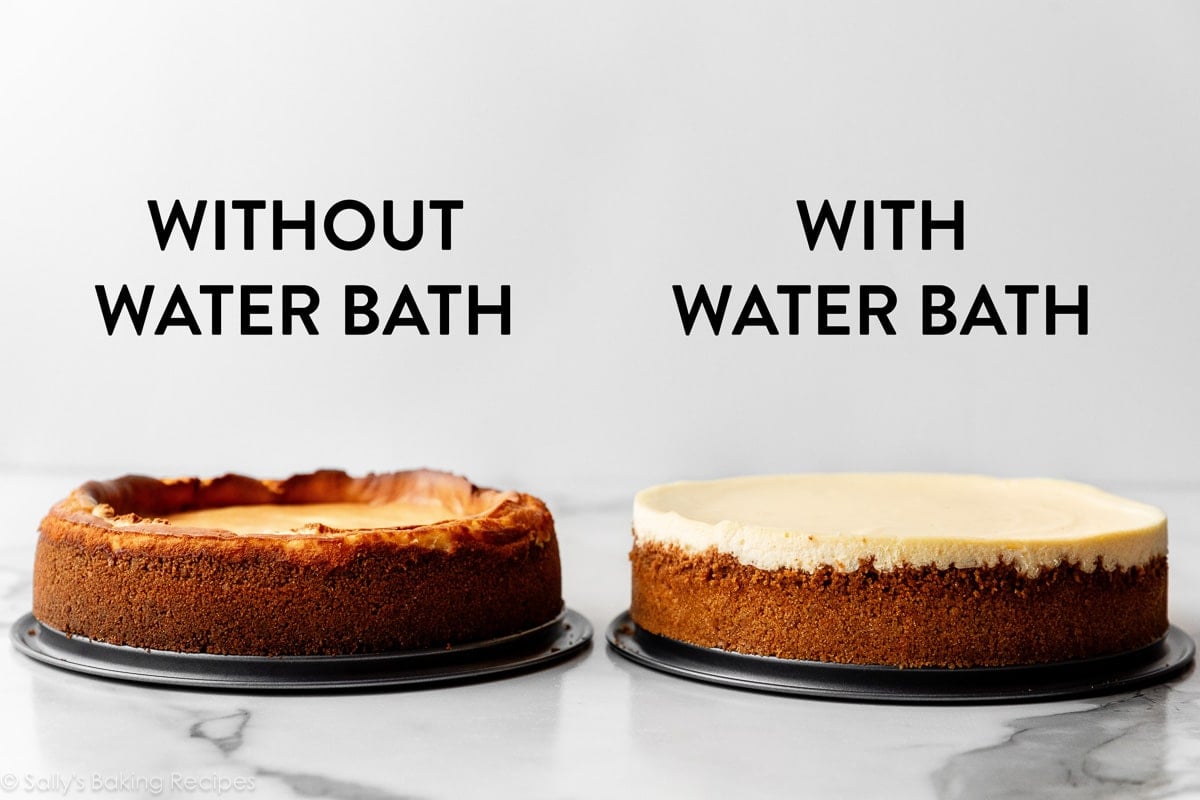
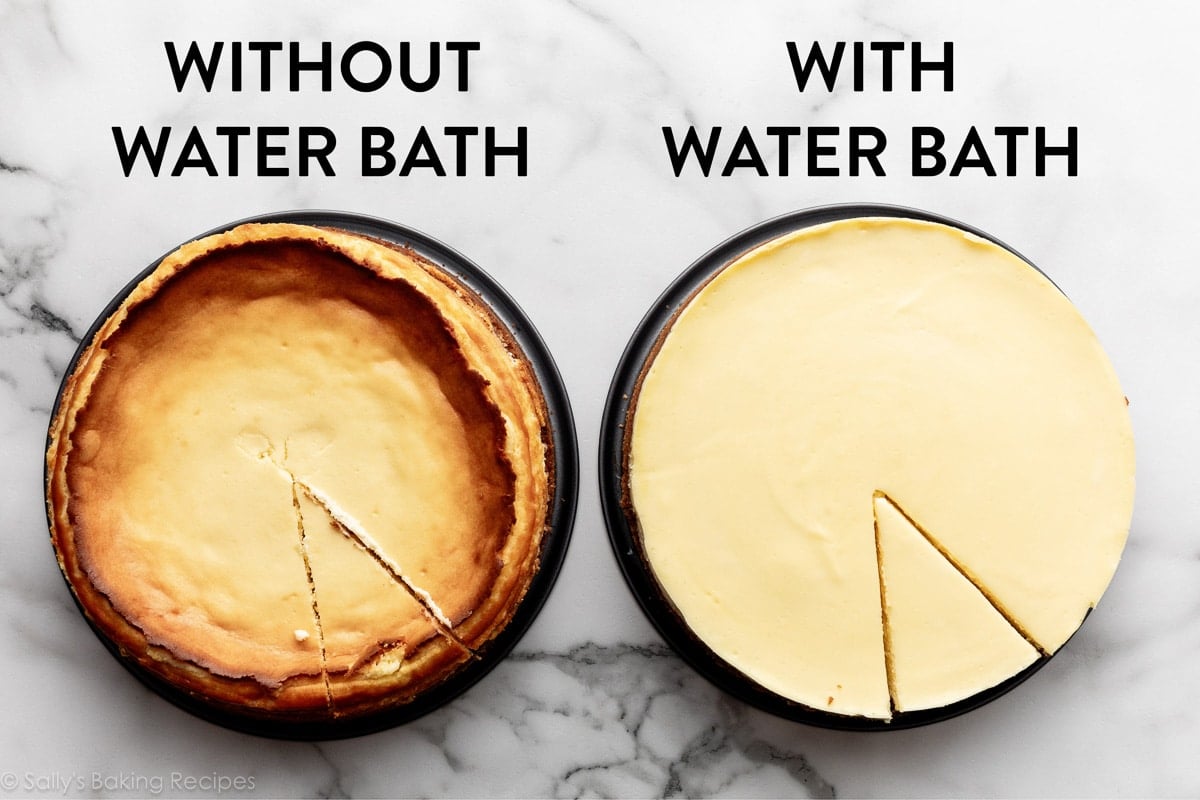

I’m going to walk you through 2 different methods for baking a cheesecake in a water bath, and both work exceptionally well.
1. How to Make a Traditional Water Bath
Here’s what you need:
- Quality springform pan (I use and love this one)
- Aluminum foil (I recommend heavy duty aluminum foil)
- Large roasting pan
- Boiling water (I use a kettle to make pouring easier)
And here’s how to do it:
- Tear or cut two pieces of foil and lay one on top of the other. After you’ve shaped your crust inside (and pre-baked the crust, if your cheesecake recipe calls for this step), place the springform pan on the double-layer sheet of foil. Fold up the sides of the foil, tightly wrapping the exterior of the cheesecake pan on the bottom and up the sides. If you pre-baked the crust, be extra careful if the pan is still hot! This foil wrap prevents water from seeping in through your springform pan.
- Boil water. You need enough to fill your large pan with about an inch of water, so I usually boil a full kettle.
- Place the foil-wrapped springform pan inside your large roasting pan. Pour and spread your cheesecake batter into the prepared crust. Place the roasting pan on the middle or lower-middle rack in your preheated oven. (You can also pour the boiling water into the roasting pan outside of the oven, and carefully transfer the pan to the oven—just be careful not to spill or splash!)
- Working quickly but carefully, pour hot water into the roasting pan, so that the wrapped springform pan is surrounded by hot water, about 1 inch deep. I usually fill with water once placed in the oven to bake because it is hard to transfer a water-filled roasting pan with a cheesecake inside of it into the oven. But, again, you can do it either way!
- Quickly shut the oven door, and bake the cheesecake.

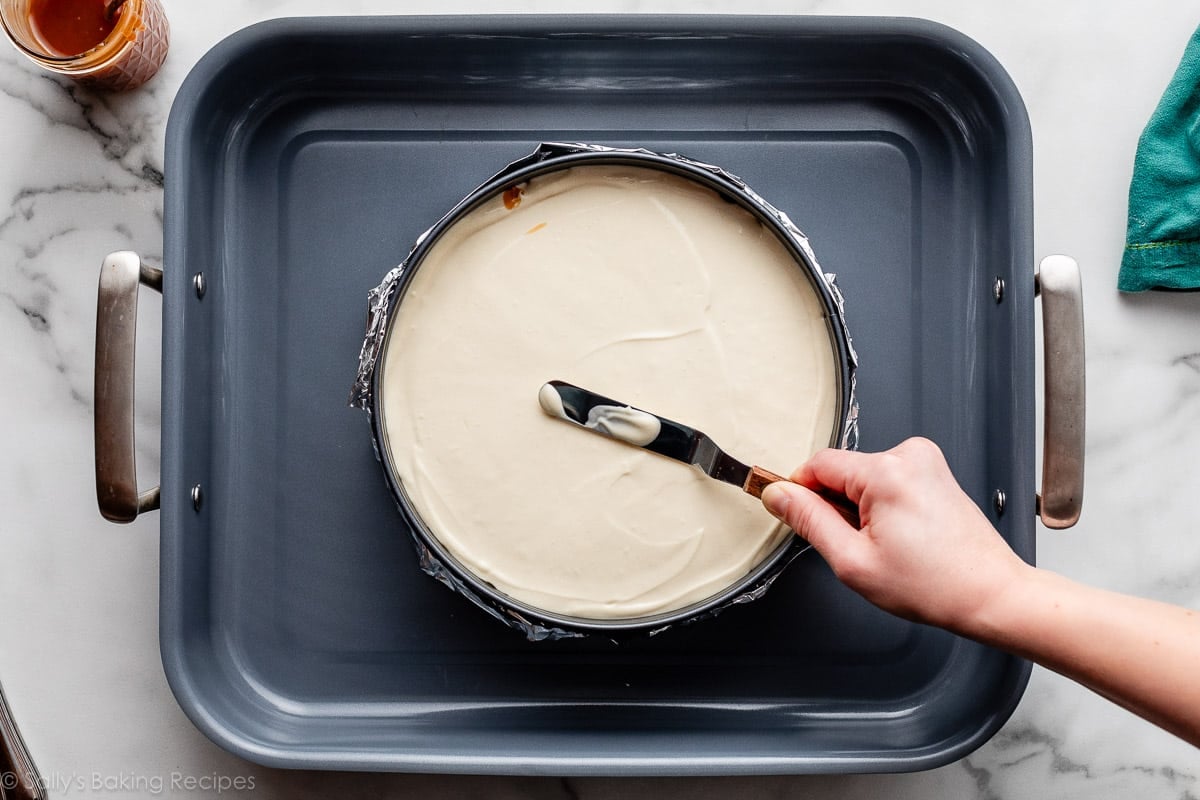
Like I mentioned, you can either place the roasting pan (with the cheesecake in it) in the oven now, and then pour in the boiling water, OR you can pour the boiling water in the roasting pan and transfer it to the oven. I took this following photo outside of the oven just to show you this step. In my video below, I do this while the pan is IN the oven. Again, either way is fine.
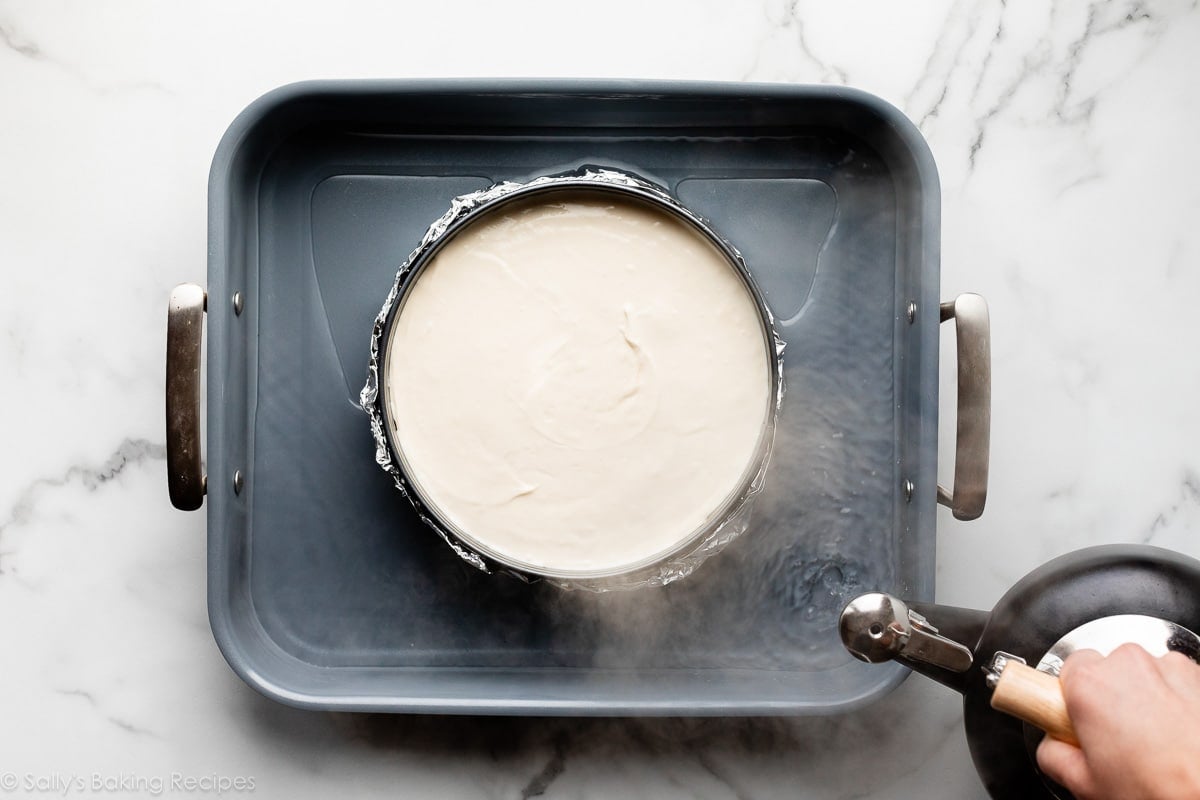

2. Alternate Option
If you don’t want to risk water leaking into your springform pan, I have an alternate water bath method that works wonderfully. You still need a large oven-safe pan, but it will go on a bottom rack of the oven, below the rack the cheesecake is on.
Here’s what you need:
- Quality springform pan (I use and love this one)
- Large oven-safe pan, such as a roasting pan, cast-iron skillet, or 9×13-inch metal baking pan (not glass)
- Boiling water (I use a kettle to make pouring easier)
And here’s how to do it:
- Boil water. You need enough to fill your large pan with about an inch of water, so I usually boil a full kettle.
- Place your cheesecake on the middle oven rack.
- Immediately place the large oven-safe pan you’re using on the bottom oven rack.
- Pour hot water into the empty pan on the bottom rack, so that it’s about 1 inch deep.
- Quickly shut the oven door, and bake the cheesecake.
This unique water bath adds steam to the oven without having the cheesecake sit inside the water itself. This method can also be used to add steam to baking artisan bread, for a crispier crust.

Cooling the Cheesecake in the Water Bath
When your cheesecake is done baking (the edges are set but the center still jiggles slightly if you tap the pan), don’t take it out of the oven. Turn the oven off and crack open the oven door so that some steam can escape. Let the cheesecake cool down slowly in the oven with the door slightly ajar for at least an hour, with the water bath (either method you used) still in the oven as well, so it remains in that humid environment while it cools gradually.
After about an hour, remove the cheesecake from the oven. Then let it cool completely on a wire rack, before transferring it to the refrigerator to chill, per your recipe instructions.
If your cheesecake is still showing a few cracks, there’s a solution for that! Whipped cream or a sauce—like salted caramel, strawberry sauce, raspberry sauce, or blueberry sauce—can cover up even the craggiest cheesecake surface. Or spread on a layer of chocolate ganache or lemon curd, whatever flavor goes best with your cheesecake.
I cover this pumpkin swirl cheesecake with whipped cream:
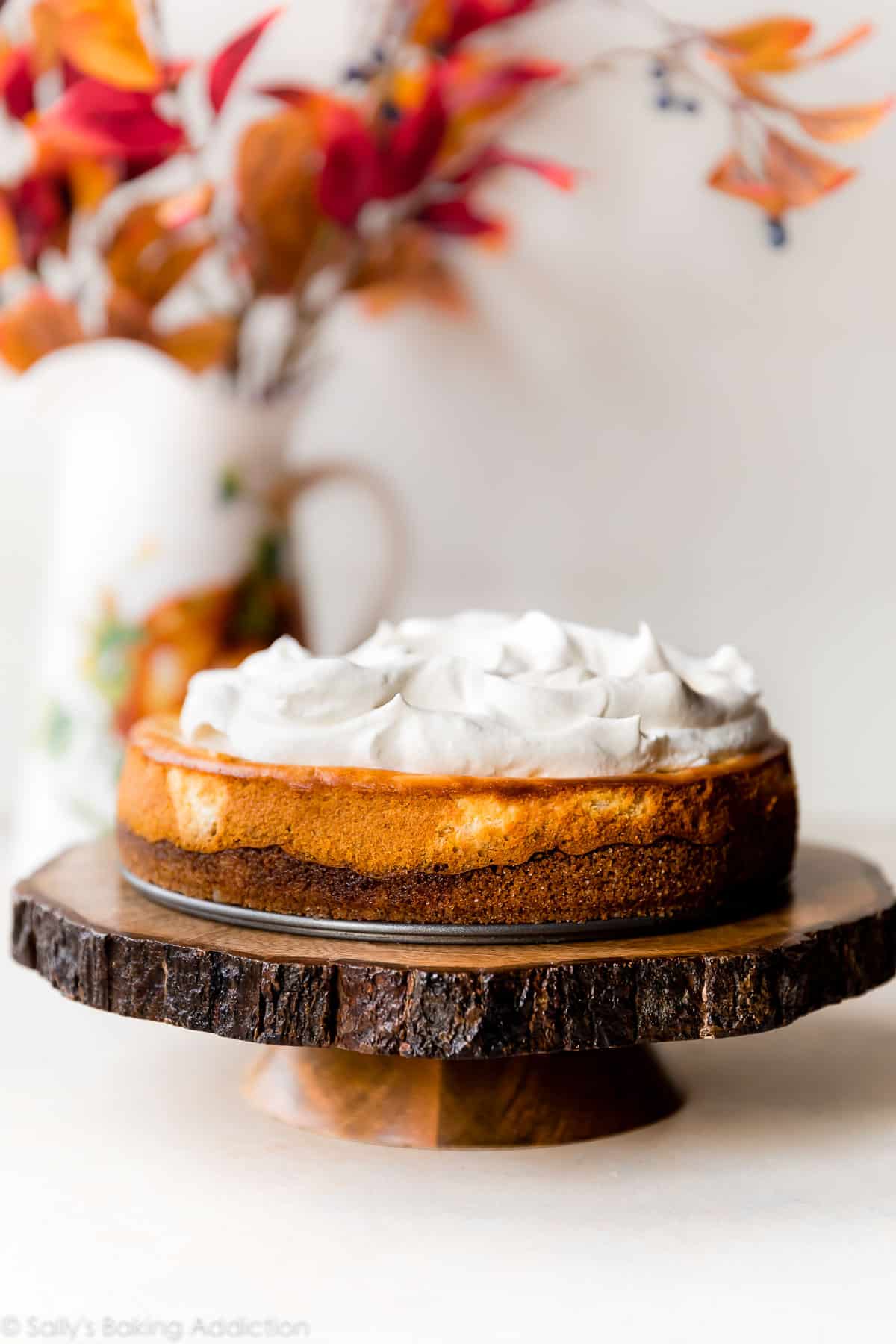
Even if your cheesecake doesn’t crack at all, toppings are always a wonderful finishing touch to your cheesecake masterpiece. So many delightful options!
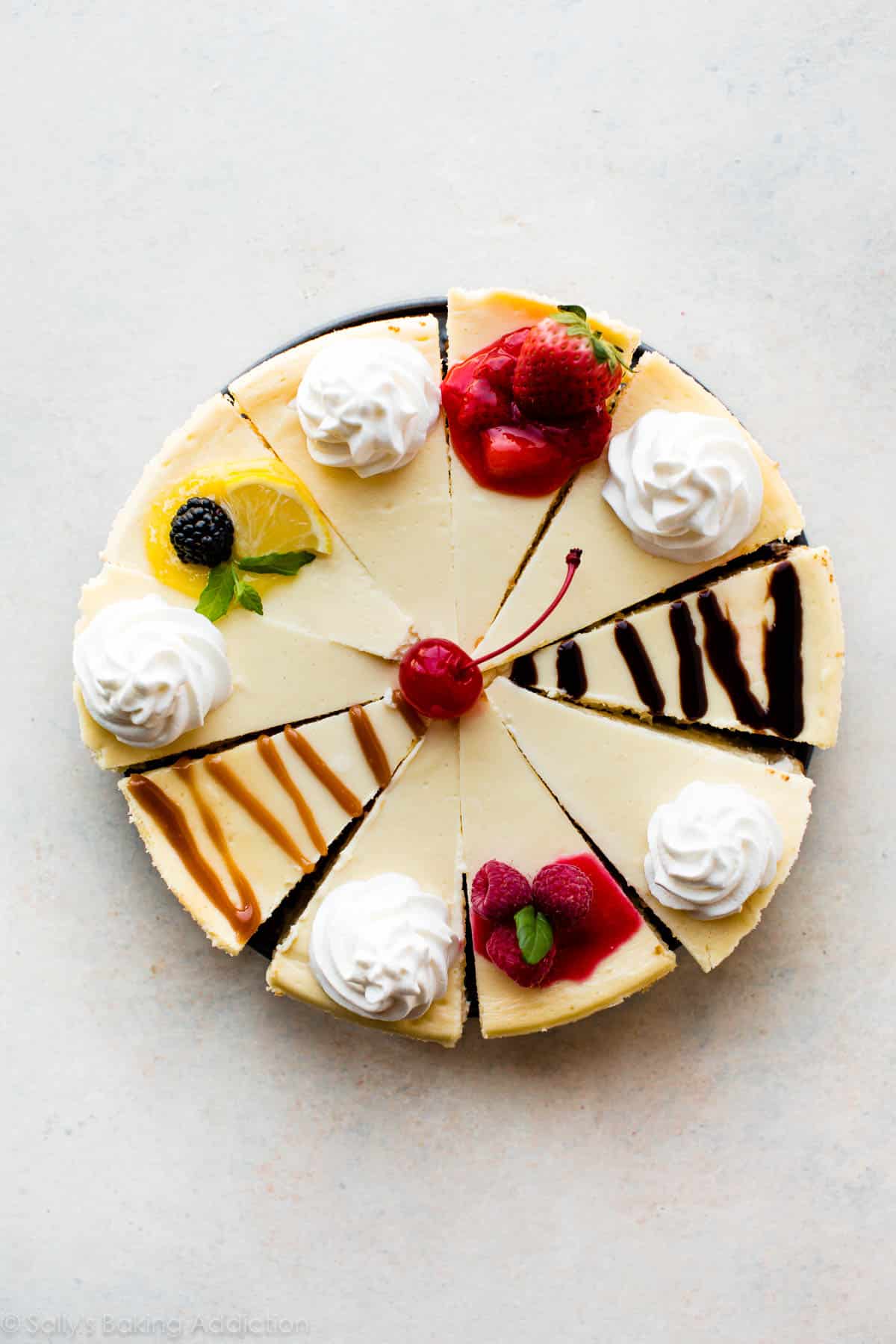
And if all this seems a little overwhelming, try a no-bake cheesecake or easy cheesecake pie instead.
Popular Cheesecake Recipes
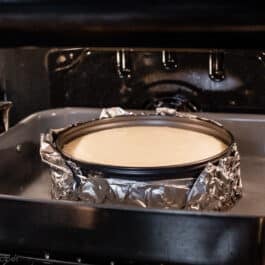
How to Make a Cheesecake Water Bath
- Prep Time: 10 minutes
- Cook Time: 1 hour
- Total Time: 1 hour, 10 minutes
- Yield: 1 cheesecake
- Category: Dessert
- Method: Baking
- Cuisine: American
Description
Baking your cheesecake in a water bath is the best way to ensure cheesecake success. Follow these directions using your own cheesecake recipe. Here is my classic cheesecake, if you’d like to try it.
Ingredients
- Cheesecake recipe, or any cheesecake that requires baking
- Springform pan (I usually use this one)
- Aluminum foil (I recommend heavy duty)
- Large roasting pan
- Kettle of water
Instructions
- Preheat oven as directed in your cheesecake recipe, and adjust an oven rack to the middle or lower-middle position.
- Make the Crust: Make the crust according to your cheesecake recipe instructions and press it into your springform pan. If your recipe calls for pre-baking the crust, bake as directed.
- Wrap the Pan: Tear or cut two large pieces of aluminum foil, and lay one on top of the other. Set the springform pan (be careful if it’s hot from the oven!) on top of the foil, and tightly wrap the foil around the outside of the pan. This will prevent any water from leaking into the cheesecake. *You can also wrap the pan before pre-baking the crust, if you’d like.* Place the wrapped springform pan inside your large roasting pan.
- Boil Water: Fill a kettle or pot with water and set over high heat to bring the water to a boil. You need 1 inch of hot water in your roasting pan for the water bath, so make sure you boil enough.
- Add the Filling: Pour/spread your cheesecake batter into the crust as directed in your recipe.
- Place the entire roasting pan with the cheesecake inside it onto the middle or lower-middle oven rack. Carefully pour the boiling-hot water into the roasting pan, so that the water is about 1 inch deep. Close the oven door quickly to trap the steam inside.
- Bake the cheesecake as directed in your recipe.
- Cool & chill the cheesecake: Turn the oven off and open the oven door slightly. Let the cheesecake sit in the oven with the water bath as it cools down for 1 hour. Remove the cheesecake from the oven and the water bath, and set the springform pan on a wire rack to cool completely. Once cooled to room temperature, refrigerate the cheesecake as directed in your recipe.
Notes
- Recommended Tools (affiliate links): 9-inch Springform Pan or 10-inch Springform Pan | Heavy Duty Aluminum Foil | Large Roasting Pan | Kettle or Electric Kettle | Cooling Rack
- Alternate Water Bath Method: Place the cheesecake (no need to wrap the springform pan in foil) on the center oven rack of the preheated oven. Place a large roasting pan or metal baking pan (do not use glass—I usually use a 9×13-inch baking pan or an extra-large cast iron skillet) on the bottom oven rack. Pour boiling-hot water into the empty pan on the bottom rack, about 1 inch deep. Immediately close oven door to trap the steam inside. This unique water bath adds steam to the oven without having the cheesecake sit inside the water itself.



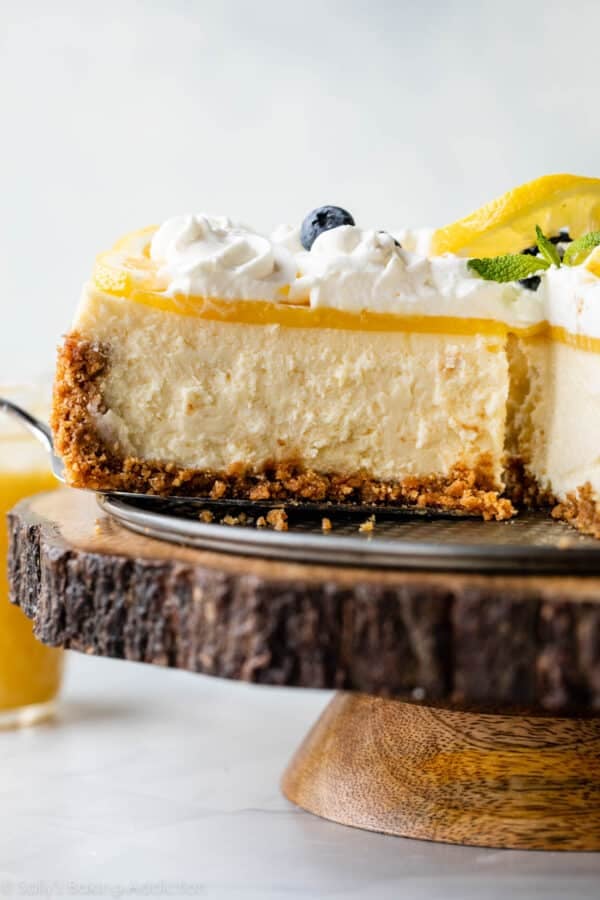
















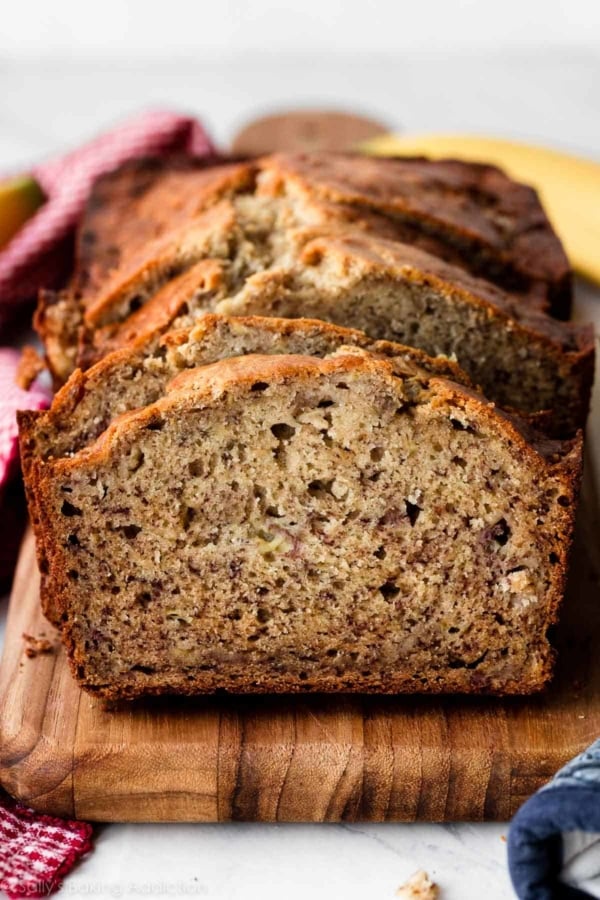

Reader Comments and Reviews
So yummy!!! My dad said this was the best cheesecake he has had in his life!